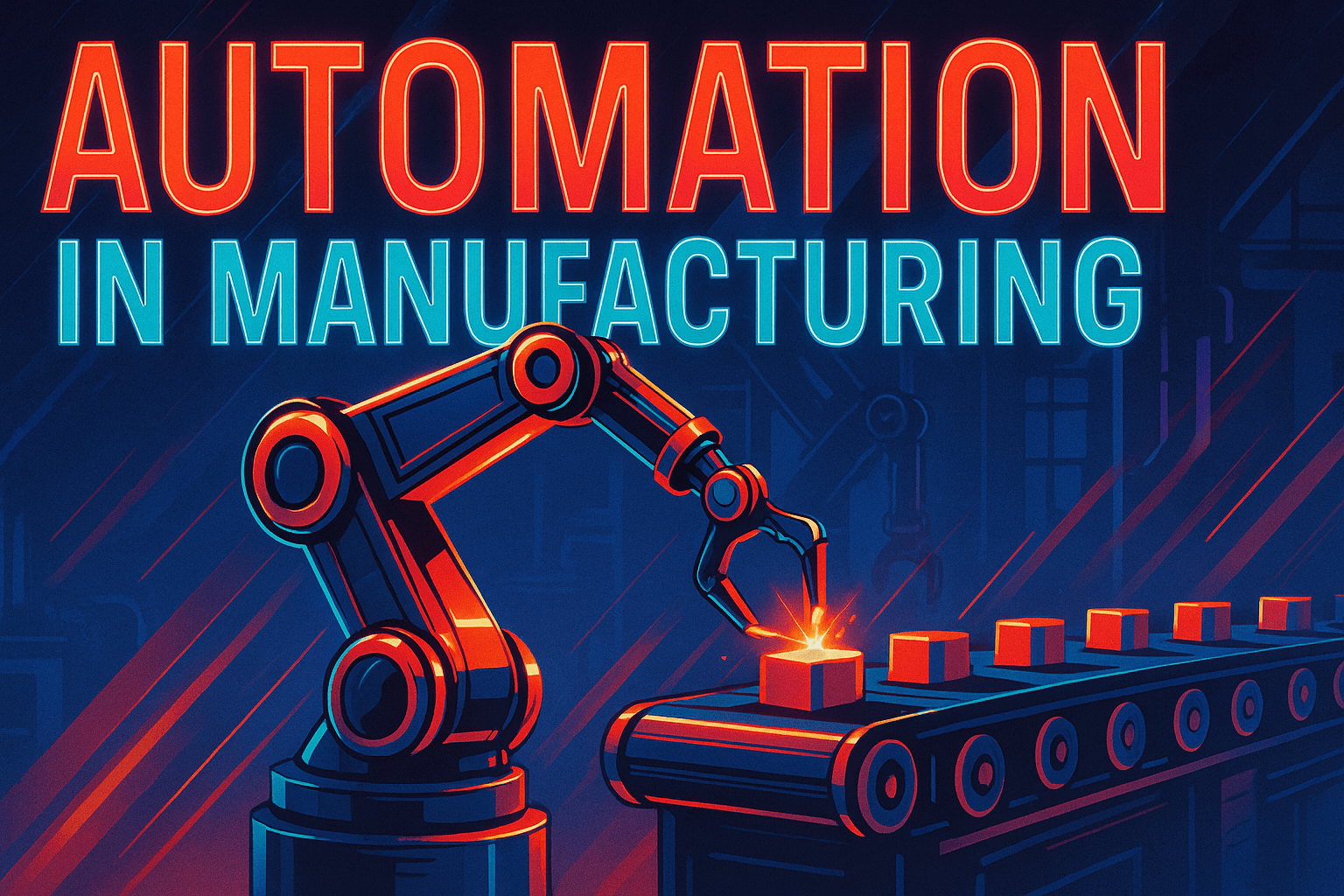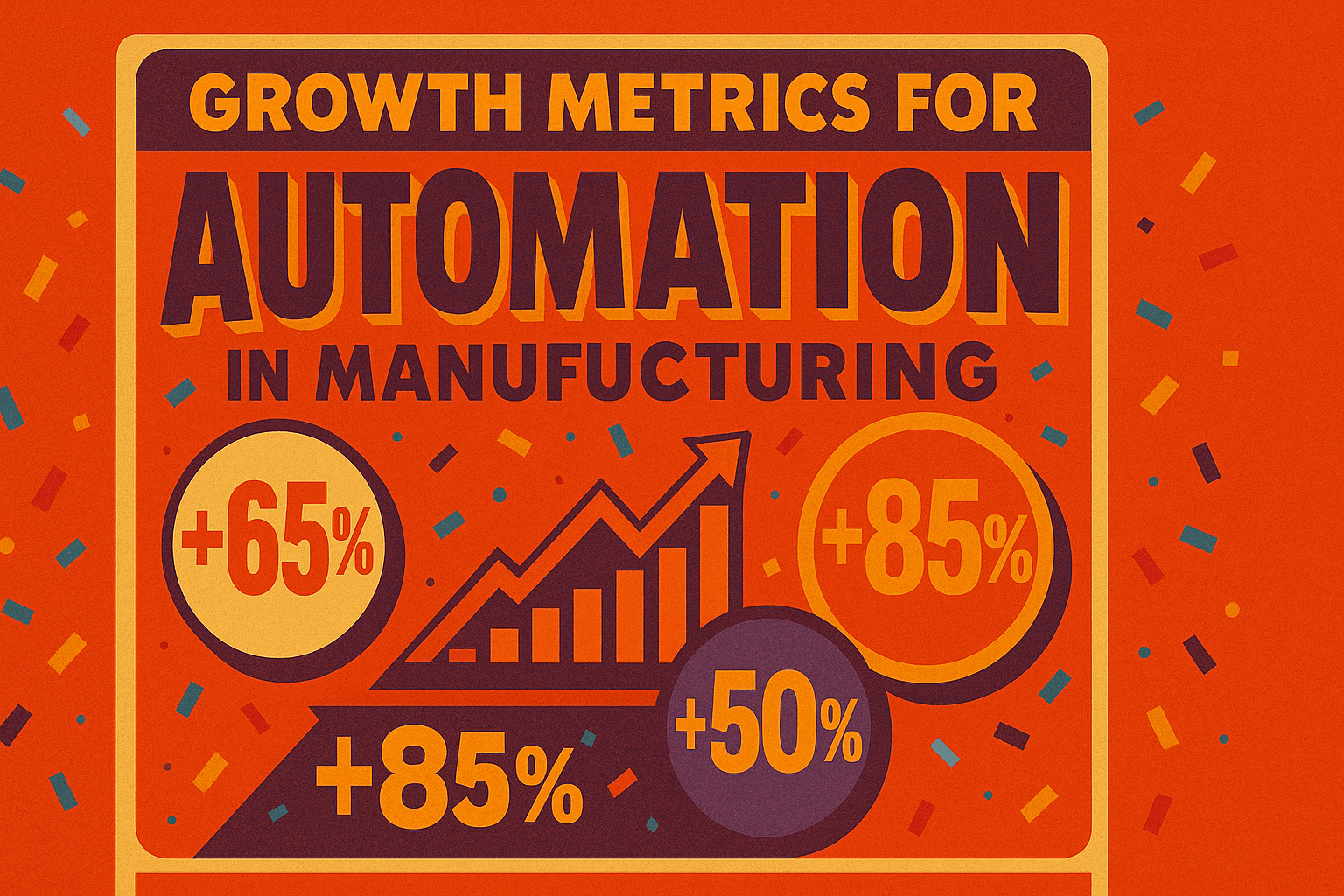Data-Driven Automation for Manufacturing: Complete Implementation Guide
by Design Delulu Editorial · October 23, 2025

Smart, fast, and measurable. Here's how Automation helps Manufacturing win.
Manufacturing operations today generate massive amounts of data, yet most companies still make critical automation decisions based on intuition rather than insights. The gap between data collection and actionable intelligence costs manufacturers millions in missed efficiency gains, quality issues, and competitive advantages. When automation initiatives lack proper measurement frameworks, teams struggle to justify investments, optimize processes, or prove ROI to stakeholders.
Data-led automation for manufacturing changes this equation entirely. By implementing robust tracking systems, attribution models, and real-time dashboards from day one, manufacturers transform raw operational data into strategic assets. This approach eliminates guesswork, enables rapid optimization cycles, and creates a foundation for continuous improvement that compounds over time. The result? Automation projects that deliver measurable outcomes, adapt to changing conditions, and provide clear visibility into what's working and what needs adjustment.

Why Data-Led Automation Matters for Manufacturing
Traditional automation projects in manufacturing often fail to deliver expected returns because they're implemented without proper measurement infrastructure. Teams deploy solutions, hope for improvement, and struggle to quantify actual impact. This approach creates uncertainty, makes optimization difficult, and leaves leadership questioning whether automation investments are worthwhile.
The data-led approach flips this model: Every automation initiative begins with clear success metrics, comprehensive tracking plans, and dashboards that provide real-time visibility into performance. This foundation enables manufacturers to:
- Prove ROI with concrete numbers: Track cost savings, efficiency gains, and quality improvements with precision, making it easy to justify current investments and secure funding for future initiatives.
- Identify bottlenecks instantly: Real-time dashboards highlight exactly where processes slow down or fail, allowing teams to address issues before they cascade into larger problems.
- Optimize continuously: With comprehensive data on what's working and what isn't, teams can make incremental improvements that compound into significant competitive advantages over time.
- Align stakeholders around shared truth: Source-of-truth dashboards eliminate debates about whether automation is working, creating alignment across operations, finance, and leadership teams.
Manufacturing companies that embrace data-led automation typically see 30-50% faster time-to-value compared to traditional implementations, along with higher adoption rates and more sustainable long-term results. The difference comes from having visibility into performance from day one, enabling rapid iteration and course correction.
Core Components of Data-Led Manufacturing Automation
Building effective automation for manufacturing requires four foundational elements working in concert. Each component plays a specific role in transforming operational data into actionable intelligence that drives measurable improvements.
1. Comprehensive Tracking Infrastructure
Modern manufacturing automation demands tracking that goes far beyond basic operational metrics. Event tracking and ecommerce integration with GA4 and server-side tagging provide the granular visibility needed to understand exactly how systems, people, and processes interact across your entire operation.
This infrastructure captures critical touchpoints:
- Equipment performance and downtime events
- Quality control checkpoints and failure modes
- Material flow and inventory movements
- Operator interactions and process deviations
- Customer order fulfillment stages
- Supply chain integration points
Server-side tagging ensures data accuracy even in challenging manufacturing environments where network connectivity may be intermittent or where privacy regulations require careful data handling. This approach provides resilience and compliance while maintaining comprehensive visibility.
2. Source-of-Truth Dashboards
Data only creates value when it's accessible and actionable. Looker Studio dashboards serve as the central nervous system for data-led automation, providing real-time visibility into key performance indicators across operations, quality, efficiency, and business outcomes.
Effective manufacturing dashboards include:
- Operations overview: Equipment utilization, throughput rates, cycle times, and downtime analysis
- Quality metrics: Defect rates, first-pass yield, scrap reduction, and compliance tracking
- Efficiency indicators: OEE (Overall Equipment Effectiveness), labor productivity, energy consumption, and material waste
- Business impact: Order fulfillment speed, on-time delivery, customer satisfaction, and cost per unit
The key is creating role-specific views that surface the right information for different stakeholders. Floor supervisors need real-time operational alerts, while executives require weekly trend analysis and strategic metrics. A well-designed dashboard hierarchy ensures everyone has access to relevant data without information overload.
3. Attribution Modeling for Manufacturing
Understanding which automation initiatives drive specific outcomes is crucial for optimizing investment and scaling what works. Attribution modeling adapted to manufacturing funnels connects upstream actions to downstream results, revealing the true drivers of performance improvements.
Manufacturing attribution differs from traditional marketing models because it must account for:
- Multi-stage production processes: Tracking how early-stage optimizations impact final quality and throughput
- Cross-functional touchpoints: Understanding how maintenance, quality control, and operations interact to drive outcomes
- Time lag effects: Recognizing that some automation benefits take weeks or months to fully materialize
- Compound improvements: Capturing how multiple small optimizations combine to create significant results
Proper attribution enables manufacturers to double down on high-impact initiatives while quickly identifying and addressing underperforming automation investments. This creates a virtuous cycle of continuous improvement guided by data rather than assumptions.
4. Data Governance Framework
Inconsistent or unreliable data undermines even the most sophisticated automation initiatives. Governance systems ensure data remains consistent, clean, and trustworthy as automation scales across facilities, shifts, and departments.
Key governance elements include:
- Standardized naming conventions: Ensuring all teams track and report metrics the same way
- Data validation rules: Automatically flagging anomalies and ensuring quality at the point of capture
- Access controls: Managing who can view, edit, and export different types of operational data
- Audit trails: Maintaining complete records of data changes for compliance and troubleshooting
- Documentation standards: Creating clear definitions for all metrics and tracking methodologies
Strong governance transforms data from a potential liability into a strategic asset, enabling confident decision-making at all levels of the organization.
Implementation Framework: Four Phases to Success
Deploying data-led automation for manufacturing follows a proven four-phase methodology that balances speed with thoroughness, ensuring teams achieve quick wins while building sustainable long-term capabilities.
Phase 1: Discovery & Goal Alignment
Success begins with clarity. This initial phase focuses on defining outcomes, understanding constraints, and establishing success metrics that will guide all subsequent decisions. Rather than jumping straight into implementation, teams invest time ensuring everyone shares the same vision and priorities.
Key activities include:
- Stakeholder interviews across operations, maintenance, quality, and leadership
- Current state assessment of existing automation and data capabilities
- Pain point identification and prioritization
- Success metric definition with specific targets and timeframes
- Constraint mapping (budget, resources, timeline, technical limitations)
- Quick win identification for early momentum
This phase typically takes 1-2 weeks and creates the foundation for rapid, aligned execution in subsequent phases. The investment in upfront clarity pays dividends by preventing costly mid-project pivots and ensuring resources focus on highest-impact opportunities.
Phase 2: Blueprint & Strategy Design
With clear goals established, teams design the comprehensive strategy, technical architecture, and measurement plan that will guide implementation. This blueprint phase transforms high-level objectives into detailed specifications that teams can execute with confidence.
Deliverables from this phase:
- Tracking plan: Comprehensive documentation of every data point to be captured, including event names, parameters, triggers, and success criteria
- Architecture diagram: Technical blueprint showing how systems integrate, where data flows, and how components interact
- Dashboard mockups: Visual representations of how data will be displayed for different user roles and use cases
- Attribution model specification: Detailed methodology for connecting actions to outcomes across the manufacturing funnel
- Implementation roadmap: Phased rollout plan with milestones, dependencies, and resource requirements
The blueprint serves as both a communication tool and an implementation guide, ensuring technical teams, operations staff, and leadership all understand what's being built and why. This shared understanding dramatically reduces implementation risks and accelerates deployment.
Phase 3: Build, QA & Launch
Implementation brings the blueprint to life through systematic deployment, rigorous testing, and controlled rollout with tracking infrastructure in place from day one. This phase emphasizes getting automation operational while ensuring data quality and system reliability.
Build process essentials:
- Staged deployment: Starting with pilot areas or lines to validate approach before full-scale rollout
- Parallel testing: Running new automation alongside existing processes to verify performance and catch issues
- Data validation: Confirming tracking accuracy through comparison with known benchmarks and manual checks
- User acceptance testing: Ensuring operators and stakeholders can effectively use new systems and dashboards
- Documentation creation: Building training materials, troubleshooting guides, and standard operating procedures
- Go-live support: Providing intensive assistance during initial deployment to address issues quickly
The build phase typically runs 2-4 weeks depending on scope and complexity. Rushing through implementation creates technical debt and adoption challenges, while excessive perfectionism delays value realization. The key is finding the right balance between speed and quality.
Phase 4: Optimize & Scale
With automation operational and data flowing, the focus shifts to continuous improvement through data-driven iteration. This ongoing phase creates the most value over time, as teams learn what works and systematically enhance performance.
Optimization strategies include:
- Weekly performance reviews: Regular examination of dashboard data to identify trends, anomalies, and opportunities
- A/B testing: Systematic experimentation with different automation parameters to find optimal settings
- Bottleneck elimination: Using data to pinpoint and address constraint points that limit overall throughput
- Best practice sharing: Documenting and replicating successful optimizations across similar processes or facilities
- Quarterly strategic resets: Stepping back to assess overall progress, adjust priorities, and plan next phases
Organizations that excel at this phase create compound improvement engines where small weekly gains accumulate into transformative competitive advantages over time. The data infrastructure built in earlier phases makes this optimization sustainable and systematic rather than ad hoc and reactive.

Best Practices for Manufacturing Automation Success
Years of manufacturing automation implementations reveal consistent patterns that separate successful projects from those that struggle. These best practices help teams avoid common pitfalls and maximize return on automation investments.
Start with Highest-Impact Opportunities
Prioritize processes, pages, and flows that directly impact key business outcomes. Rather than trying to automate everything at once, identify the 20% of processes that drive 80% of results. This might be high-volume production lines, quality-critical operations, or bottleneck processes that constrain overall throughput.
Use a simple prioritization matrix:
- High impact + easy implementation: Start here for quick wins and momentum
- High impact + difficult implementation: Tackle after building experience with easier projects
- Low impact + easy implementation: Consider if resources allow, but don't prioritize
- Low impact + difficult implementation: Avoid unless required for compliance or other non-negotiable reasons
Integrate Creative with Measurement
Every automation initiative, dashboard, and report should have clear KPIs defined before implementation. This discipline ensures teams don't create automation for its own sake but rather focus on solving specific problems with measurable success criteria.
Assign ownership for each KPI to create accountability:
- Operations managers own throughput and efficiency metrics
- Quality teams own defect rates and compliance measures
- Maintenance owns uptime and reliability indicators
- Finance owns cost reduction and ROI tracking
This clear ownership structure ensures someone is always watching the data and ready to act when metrics indicate problems or opportunities.
Build Systems and Templates for Scale
Develop reusable frameworks, templates, and standard operating procedures that enable rapid deployment of automation across multiple facilities, lines, or processes. Every successful implementation should leave behind artifacts that make the next implementation faster and better.
Critical scaling elements:
- Tracking plan templates: Pre-built frameworks that can be customized for specific use cases
- Dashboard templates: Standard layouts for common manufacturing metrics that ensure consistency
- Integration playbooks: Step-by-step guides for connecting specific equipment types or software systems
- Training modules: Reusable materials for onboarding new users and facilities
- Troubleshooting guides: Common issues and solutions documented for quick problem resolution
Organizations that build strong templates typically see 50-70% reduction in implementation time for subsequent automation projects compared to their first implementation.
Close the Loop with Regular Reviews
Establish weekly data review meetings and quarterly strategic resets to ensure automation continues delivering value over time. Without regular review cadences, teams lose focus, metrics drift, and automation gradually becomes less effective.
Effective review structures:
- Daily huddles (5-10 minutes): Quick review of critical metrics and immediate issues requiring attention
- Weekly deep dives (30-45 minutes): Detailed examination of trends, testing results, and optimization opportunities
- Monthly business reviews (1-2 hours): Cross-functional assessment of overall performance and strategic alignment
- Quarterly strategic planning (half-day): Comprehensive evaluation of progress, lessons learned, and next-phase priorities
These regular touchpoints create accountability, maintain focus, and ensure data insights translate into action rather than sitting unused in dashboards.
Industry-Specific Strategies for Manufacturing
Manufacturing presents unique challenges and opportunities for data-led automation. These industry-specific strategies help teams navigate common obstacles and capitalize on manufacturing-specific advantages.
Map Search Intent to Buyer Journey Stages
For manufacturers selling products or services, understanding how potential customers search and research manufacturing solutions enables better automation of marketing and sales processes. Different search queries indicate different stages in the buyer journey, requiring different content and follow-up approaches.
Early-stage searches (awareness) include broad terms like "improve manufacturing efficiency" or "reduce production costs." These searchers need educational content and problem validation.
Mid-stage searches (consideration) include specific solutions like "automation for injection molding" or "quality control systems." These buyers understand their problem and are evaluating approaches.
Late-stage searches (decision) include vendor comparisons, pricing inquiries, and specific implementation questions. These prospects are ready for proposals and detailed discussions.
Automating appropriate responses based on search intent ensures leads receive relevant information that moves them toward purchase rather than generic content that fails to address their specific needs.
Deploy Social Proof Early in the Journey
Manufacturing buyers are inherently risk-averse because production disruptions carry massive costs. Using automation to surface relevant case studies, testimonials, and outcome data early in the buyer journey builds confidence and accelerates decision-making.
Effective social proof automation includes:
- Industry-specific case studies: Automatically serving examples from similar manufacturing sectors
- Outcome-focused testimonials: Highlighting concrete results ("15% throughput increase") rather than vague praise
- Video factory tours: Showing automation in action at customer facilities
- Third-party validation: Industry awards, certifications, and analyst recognition
- Customer success metrics: Aggregated performance data from multiple implementations
This evidence-based approach aligns perfectly with the data-driven culture of manufacturing organizations and accelerates trust-building.
Maintain Single Source of Truth Reporting
Manufacturing organizations often struggle with conflicting data from different systems (ERP, MES, quality management, maintenance systems). This fragmentation creates debates about actual performance and undermines confidence in automation initiatives.
Establishing a single source of truth dashboard that integrates data from all relevant systems eliminates these conflicts. Key principles:
- Clear data hierarchy: Define which system is authoritative for each metric type
- Transparent calculations: Document exactly how composite metrics are calculated
- Reconciliation processes: Regular checks to ensure integrated data matches source systems
- Version control: Track dashboard changes and maintain historical definitions
- Access governance: Control who can modify core metrics versus create custom views
This unified reporting approach creates organizational alignment and enables faster, more confident decision-making across all levels.
Ship Small, Test Fast, Compound Wins
Manufacturing automation projects often fail because teams attempt massive transformations that take months or years to deliver results. Breaking large initiatives into small, testable increments creates momentum, enables rapid learning, and delivers value continuously rather than in one distant future state.
Effective incremental approach:
- Identify minimal viable automation: What's the smallest implementation that creates measurable value?
- Deploy and measure: Get it running with proper tracking within 2-4 weeks maximum
- Learn and adjust: Use data to understand what works and what needs improvement
- Scale or pivot: Expand successful implementations while quickly abandoning or redesigning failures
- Repeat: Establish a rhythm of continuous small improvements that compound over time
This approach transforms automation from a risky bet into a systematic capability that consistently delivers measurable improvements.

Measuring Success: Key Metrics for Manufacturing Automation
Effective measurement requires tracking metrics at multiple levels, from tactical operational indicators to strategic business outcomes. This comprehensive view ensures teams optimize for overall impact rather than gaming individual metrics.
Operational Efficiency Metrics
- Overall Equipment Effectiveness (OEE): Composite measure of availability, performance, and quality
- Cycle time reduction: How much faster processes complete after automation
- Changeover time: Speed of transitioning between different products or configurations
- First-pass yield: Percentage of products meeting quality standards without rework
- Unplanned downtime: Frequency and duration of unexpected production interruptions
Quality and Compliance Metrics
- Defect rate: Percentage of products failing quality checks
- Scrap reduction: Decrease in material waste from improved process control
- Compliance adherence: Percentage of operations meeting regulatory requirements
- Audit findings: Number and severity of issues identified during inspections
- Traceability completeness: Ability to track products through entire production process
Business Impact Metrics
- Cost per unit: Total production cost divided by units produced
- On-time delivery rate: Percentage of orders fulfilled by promised date
- Customer satisfaction scores: Feedback on product quality and delivery performance
- Lead time reduction: Decrease in time from order to delivery
- Return on automation investment: Financial return compared to implementation costs
Data and System Health Metrics
- Data completeness: Percentage of expected data points successfully captured
- Dashboard adoption: How many users regularly access performance data
- Alert response time: How quickly teams react to automated notifications
- System uptime: Reliability of automation and data infrastructure
- Integration success rate: Percentage of data transfers completing without errors
The specific metrics that matter most vary by organization, but the key is establishing leading indicators that predict business outcomes rather than only tracking lagging indicators that report what already happened. This forward-looking approach enables proactive optimization rather than reactive problem-solving.
Common Implementation Challenges and Solutions
Even well-planned automation initiatives encounter obstacles. Recognizing common challenges and having proven mitigation strategies ready helps teams maintain momentum when difficulties arise.
Legacy System Integration
Challenge: Older manufacturing equipment and software often lack modern integration capabilities, making data collection difficult or impossible through standard methods.
Solutions:
- Use edge computing devices to capture data from equipment sensors and displays
- Implement middleware platforms that translate between legacy protocols and modern APIs
- Start with manual data entry for critical metrics while planning longer-term integration
- Consider sensor retrofits for equipment worth keeping but lacking connectivity
Data Quality Issues
Challenge: Inconsistent data entry, sensor errors, and system glitches create unreliable data that undermines confidence in automation insights.
Solutions:
- Implement automated validation rules that flag suspicious data in real-time
- Create clear data entry standards with training and regular audits
- Build redundancy into critical measurements using multiple data sources
- Establish clear ownership for data quality with specific accountability
Resistance to Change
Challenge: Operators, supervisors, and managers may resist automation due to concerns about job security, increased oversight, or skepticism about benefits.
Solutions:
- Involve frontline workers in automation design to incorporate their expertise
- Focus messaging on how automation eliminates frustrating tasks rather than replacing people
- Share early wins and success stories to build momentum and credibility
- Provide comprehensive training that builds confidence with new systems
Scope Creep
Challenge: Projects expand beyond original plans as stakeholders request additional features, metrics, or integrations, delaying delivery and inflating costs.
Solutions:
- Maintain a strict definition of "Phase 1" scope with a backlog for future enhancements
- Require formal change requests with impact assessment for any scope additions
- Use the phased approach to defer good ideas to future iterations
- Regularly communicate progress toward original goals to maintain focus
Future Trends in Manufacturing Automation
The landscape of manufacturing automation continues evolving rapidly. Understanding emerging trends helps organizations prepare for future capabilities and avoid investing in approaches that will soon be obsolete.
AI-Powered Predictive Automation
Machine learning models are moving beyond descriptive analytics to predictive systems that anticipate problems before they occur. These systems analyze patterns in operational data to forecast equipment failures, quality issues, and process deviations, enabling proactive intervention rather than reactive troubleshooting.
Digital Twin Integration
Virtual replicas of physical manufacturing processes enable testing and optimization in simulation before implementing changes in production. Digital twins fed by real-time data create safe environments for experimentation, dramatically reducing the risk and cost of process improvements.
Edge-to-Cloud Architectures
Hybrid approaches that combine edge processing for real-time decisions with cloud analytics for strategic insights are becoming standard. This architecture provides the responsiveness needed for manufacturing while maintaining comprehensive data visibility for optimization.
Augmented Reality Integration
AR systems that overlay data-driven guidance onto physical equipment are transforming training, maintenance, and quality control. These tools make automation insights accessible in the context where they're needed, reducing errors and accelerating skill development.
Getting Started: Your Next Steps
Transforming manufacturing operations with data-led automation begins with commitment to measurement-driven decision making. Organizations ready to move forward should focus on three immediate actions:
First, assess your current state honestly. What data do you already collect? How is it used for decision-making? Where are the gaps between data collection and actionable insights? This baseline understanding reveals opportunities and helps prioritize initial automation investments.
Second, identify one high-impact process for pilot implementation. Choose something important enough to matter but contained enough to implement in 4-8 weeks. This first project builds experience, proves concepts, and creates momentum for broader automation initiatives.
Third, assemble the right team combining operational expertise with technical capabilities. Successful manufacturing automation requires people who understand processes, data, technology, and change management. Don't attempt this with only one perspective represented.
The manufacturers winning with automation aren't necessarily the ones with the biggest budgets or most advanced equipment. They're the organizations that commit to data-driven decision making, implement systematically, and optimize continuously. That approach is available to any manufacturing organization willing to invest in proper measurement infrastructure and disciplined execution.
Frequently Asked Questions
Let’s level up your Manufacturing business
Need services that actually move the needle for Manufacturing? See our approach, pricing, and timelines—then book a quick call.
Additional Resources
- Schedule Your Automation Strategy Call
Book a complimentary 30-minute consultation to discuss your manufacturing automation goals. We'll assess your current state, identify high-impact opportunities, and outline a customized implementation roadmap tailored to your specific needs.
- View Our Manufacturing Automation Portfolio
Explore real-world case studies showcasing manufacturing automation implementations across various industries. See concrete examples of tracking systems, dashboard designs, and measurable ROI from completed projects.
- Access Free Manufacturing Automation Tools
Download our free automation assessment templates, tracking plan frameworks, and dashboard design kits. These practical resources help manufacturing teams kickstart their data-led automation journey with proven, ready-to-use templates.
Related Reading

Discover how automation for electricians streamlines scheduling, invoicing, lead tracking, and customer follow-ups to boost revenue and efficiency. Get started today.

Discover how automation streamlines furniture & home decor operations with GA4 tracking, attribution modeling, and data-driven dashboards. Get your 90-day implementation roadmap.
